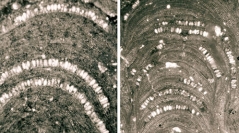

 Geodiversitas
34 (1) - Pages 151-166
Geodiversitas
34 (1) - Pages 151-166We investigated the distribution of the red algae assemblages along the depositional profile of the Attard carbonate ramp of Malta (Chattian). The Attard member is ascribed to the Lower Coralline Limestone Formation characterized by 4 members: Maghlaq, Attard, Xlendi and Il Mara. Coralline algae are present in the inner and middle ramp environments of the Attard member. Sporolithaceans and melobesioids dominate the inner ramp, while mastophoroids and peyssonneliaceans are subordinate. In the middle ramp the association of red algae is characterized by an increase of sporolithacenas and a decrease of melobesioids, mastophoroids and peyssonneliaceans. These assemblages are related to the depth gradient existing from the inner relatively shallow to the progressively deeper middle ramp. However, transportation of red algae down slope may have had an effect on the red algae associations. The shape, morphology and structure of rhodoliths in the inner ramp environment are indicative of high-energy conditions. Nevertheless localized sectors of inner ramp are characterized by morphologies typical of low energy probably related to the presence of areas colonized by seagrass. Rhodoliths from the middle ramp have characteristics of moderately highenergy. The presence of Sporolithon Heydrich and Lithoporella (Foslie) Foslie indicates that the production of carbonate took place under tropical conditions. We suggest that the Mg/Ca ratios may had a control on the flourishing of coralline algae in the Oligocene carbonate factories situated in oligo- to mesotrophic conditions, whereas during Early to Middle Miocene times the trophic conditions were one of the main controlling factor.
Coralline algae, Oligocene, carbonate ramp, paleoecology, Malta